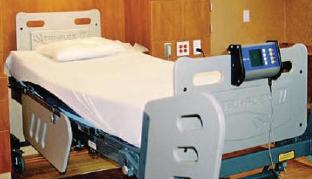Copper Cabling Speeds Communications on Medical Campus
Category 6+ Cabling Carries Medical Images and Records to Backbone of Network
Medical care has steadily improved in recent years with improved imaging being one important factor and better management of patient records another. The sharing of medical images and records is aided by advanced networks in modern medical centers. Such data may be needed for patient evaluation and consultation with experts. Timely access can save lives.
 A Carson Tahoe Medical Campus hospital bed outfitted with Category 6+ Cabling.
A Carson Tahoe Medical Campus hospital bed outfitted with Category 6+ Cabling. Photo Credit: Superior Essex
High-resolution version of this photo.
The Carson Tahoe Medical Campus in Nevada sets a benchmark for what can be done with digital networks in a hospital setting. A high-speed, scalable, flexible data network interconnects all buildings on the 87-acre campus, including a newly constructed regional medical center as well as a center for surgery and imaging. These buildings are equipped with state-of-the-art medical equipment and communications services, which allow caregivers to easily access comprehensive patient records at the bedside or point-of-care.
The campus combines the best features of copper cabling, wireless handsets and fiber optics into a seamless network. VoIP is creating extensive flexibility, allowing staff to place and answer calls from any location in the hospital using a wireless handset. For the horizontal, the Category 6+ copper cabling solution provides a reliable, no-risk performance in demanding, high-traffic networks. A fiber optic cabling system provides the backbone of the network.
"One of our goals is to create a 100-percent digital environment." said Chief Information Officer Michael Blair, who oversees Carson Tahoe's technology program. "That is a very bandwidth-intensive service. To create a reliable system, we needed a very strong and fast cabling network to transfer the images and data from place to place. The benefit of this change was immediate."
A single voice and data platform was installed to support an all-digital, film-less imaging environment, electronic medical records, computerized workstations, wireless connectivity, and Voice over Internet Protocol (VoIP) telephone system.
Multiple new digital records management systems are helping doctors order diagnostic tests and view the results, chart patient information, track patient satisfaction, order and process medications as well as send, retrieve and store large images such as x-ray, radiology, cardiology, digital mammography that demand crisp clarity.
Now, patient information can be accessed and healthcare decisions made by an authorized caregiver wherever there is a web-enabled PC. Cu
Also in this Issue:
- Staying Cool with Copper
- Copper Cabling Speeds Communications on Medical Campus
- Copper Provides Protection Underneath the Surface
- Past, Present and Future: Copper Continues to Be a Construction Mainstay
- Hospitals Turn to Copper for Reliability Where It Matters Most
